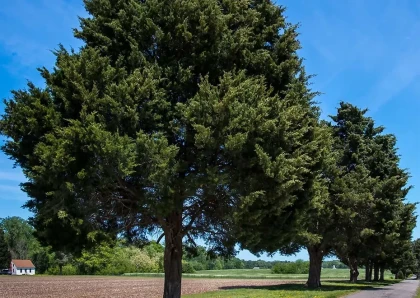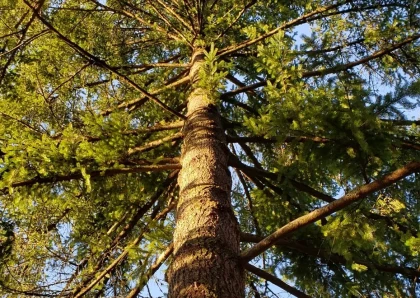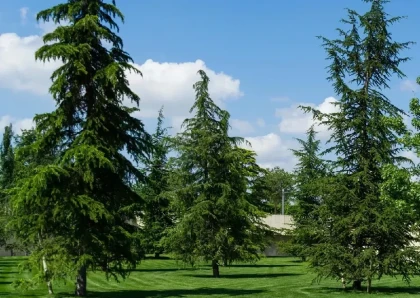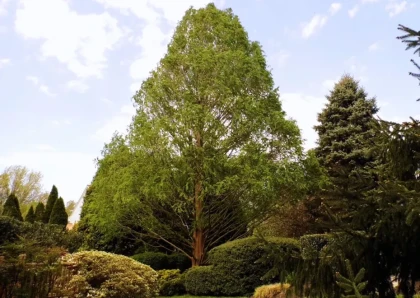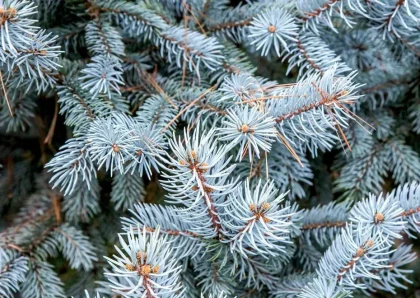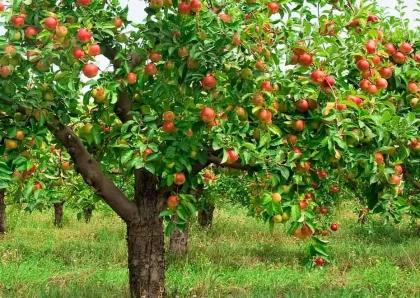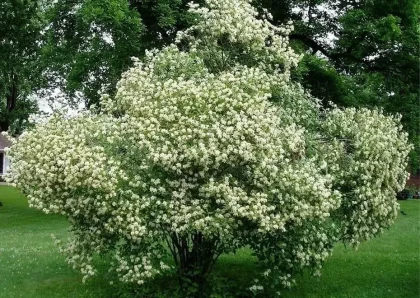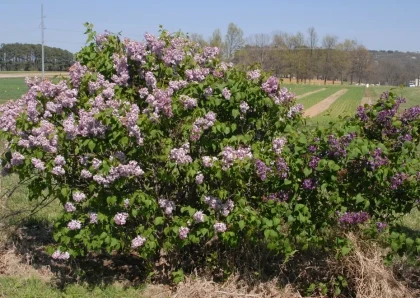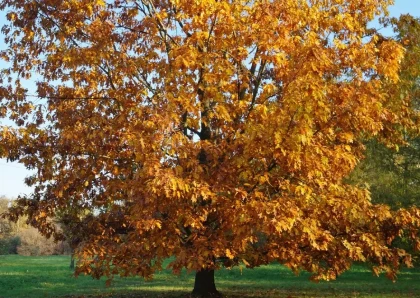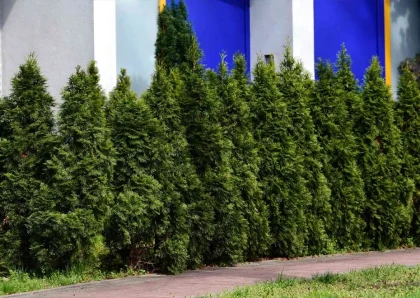
Korean Spruce
Overview
The Korean Spruce is a magnificent example of an evergreen conifer, recognized for its beautiful foliage and symmetrical, pyramidal shape. This tree grows naturally in the mountainous regions of the Korean Peninsula and northeastern China, where it thrives in the cold, high-altitude climates.
This species is notable for its vibrant blue-green needles that give it an almost shimmering appearance, especially when caught in the light. These needles are arranged radially around the branch, creating a beautiful, dense display that remains throughout the year, even in harsh winter conditions.
One standout feature of the Korean Spruce is its cones. They mature to an impressive length, often reaching up to 10 cm, and turn a brownish color upon maturing. The cones' elongated, cylindrical shape adds another layer of visual interest to this already striking tree.
Beyond its ecological role, the Korean Spruce also holds cultural importance. In Korea, it's traditionally associated with strength and endurance, often symbolizing the spirit of the Korean people. This tree is also a popular choice for bonsai enthusiasts due to its elegant form and adaptability.
Different types of wood products can be made from Korean Spruce?
- Construction: Korean Spruce wood can be utilized in general construction applications, particularly in its native regions. The wood's relative lightness combined with its strength makes it suitable for interior purposes such as paneling, flooring, and trim.
- Paper Production: In the pulp and paper industry, the wood from the Korean Spruce can be pulped to create paper products. The fibers in spruce wood are long, lending themselves well to the papermaking process and resulting in a strong, durable paper.
- Crafts and Musical Instruments: Given its straight grain and workability, Korean Spruce wood could potentially be used in crafting small items, including musical instruments. The resonant quality of spruce wood makes it a good choice for the soundboards of string instruments, although species like Sitka or Engelmann spruce are more traditionally used.
- Furniture While not as commonly used as other spruces for furniture, Korean Spruce wood could be employed in furniture making, particularly for pieces that do not require the highest durability, such as bookcases or picture frames.
Benefits of Korean Spruce
- Aesthetic Appeal The most noticeable benefit of the Korean Spruce is its remarkable visual appeal. With its dazzling blue-green needles, densely arranged in a neat, pyramidal form, this tree adds a splash of color and structure to any landscape.
- Versatility in Landscaping: Beyond its beauty, the Korean Spruce is incredibly versatile when it comes to landscaping. Its dense growth habit makes it an excellent choice for windbreaks or privacy screens, offering a natural barrier against the wind and prying eyes.
- Pollution Tolerance: Another significant benefit of the Korean Spruce is its moderate tolerance to urban pollution. This makes it a suitable choice for city landscapes or areas with higher levels of air pollution.
- Wildlife Habitat: The dense growth of the Korean Spruce provides a good habitat for local wildlife. Birds may nest in its branches, and its cones provide food for various animals.
- Adaptability to Climate: Native to cold, high-altitude environments, the Korean Spruce is hardy and can withstand low temperatures.
- Low Maintenance: Once established, the Korean Spruce is relatively low maintenance. It's a durable tree that requires little pruning, and can resist common pests and diseases, making it a practical choice for gardeners of all experience levels.
Cons of Korean Spruce
- Soil Requirements: One of the main cons of the Korean Spruce is its need for well-drained soil. Like many spruces, this tree does not tolerate waterlogged conditions, which can lead to root rot and other issues.
- Pests and Diseases: Like all plants, the Korean Spruce can be susceptible to certain pests and diseases. Aphids, spruce budworm, and spruce gall adelgid are some pests that can affect it.
- Size Considerations: Korean Spruce trees can grow quite large, reaching heights of up to 60 feet. This might be an issue in smaller landscapes where space is limited.
Tips for planting and maintaining Korean Spruce
- Site Selection Choose a location for your Korean Spruce that receives full sun to partial shade. This tree is adaptable to various light conditions but grows best with at least a few hours of direct sunlight each day.
- Soil Preparation: The Korean Spruce prefers well-drained soil. Before planting, prepare the site by loosening the soil and amending with compost or other organic matter if necessary to improve drainage.
- Planting: Dig a hole twice as wide and just as deep as the root ball of your tree. Place the tree in the hole, making sure that the top of the root ball is level with the surrounding soil. Backfill the hole with the excavated soil and firm gently to remove air pockets.
- Watering: After planting, water your Korean Spruce thoroughly and keep the soil evenly moist for the first few months while the tree establishes its root system.
- Mulching: Apply a layer of mulch around the base of the tree, leaving a gap around the trunk. Mulch helps retain soil moisture and suppresses weed growth, reducing competition for resources.
- Fertilizing: Generally, Korean Spruce does not require regular fertilization. However, if your soil is poor, you may consider an annual application of a slow-release, balanced fertilizer in the early spring.
- Pruning: Korean Spruce usually requires little pruning. However, if you wish to maintain a certain size or shape, or if there are diseased or damaged branches, you can prune in late winter or early spring when the tree is dormant.
- Monitoring for Pests and Diseases: Keep an eye on your tree for signs of pests like aphids or spruce budworm, or diseases such as needle cast or canker. Early detection is key to managing these problems and keeping your tree healthy.
Conclusion
Korean spruce is a beautiful and versatile tree. It is a popular ornamental tree and is also used for timber and Christmas trees. However, it is important to be aware of the susceptibility to pests and diseases before planting Korean spruce. While it does require some care and attention, the reward is a beautiful, robust tree that can serve a variety of purposes in your landscape.
FAQs
- Is Korean spruce edible?
- How tall does Korean spruce grow?
- What is the lifespan of Korean spruce?
No, Korean spruce is not edible. The needles are toxic to humans and animals.
Korean spruce can grow up to 100 feet tall.
Korean spruce can live for up to 200 years.
No listings available
Related Products
Questions & Answers
What do you want to know about this product?
Reviews (5)
EvergreenEnthusiast79
The Blue-Green Beauty
Korean Spruce's vibrant blue-green needles and graceful shape create an enchanting presence in my garden. A true standout!
WindWarrior44
A Sturdy Windbreak Wonder
Korean Spruce's dense foliage and pyramidal form make it a perfect windbreak. It has withstood strong gusts and protected my garden flawlessly.
LandscapeArtist21
Majestic Marvel in my Landscap
Korean Spruce adds elegance and charm to my landscape design. Its year-round beauty and wildlife-friendly features are unparalleled.
HardyGardener63
The Reliable Evergreen
Korean Spruce has thrived in my garden for years, withstanding cold winters and hot summers. A resilient and dependable choice.
ZenGardener27
A Symbol of Tranquility
Korean Spruce exudes an air of peace and serenity in my outdoor space. Its soothing presence is a balm for the soul.




